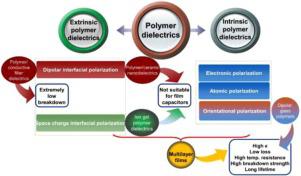Progress in Polymer Science ( IF 26.0 ) Pub Date : 2020-05-17 , DOI: 10.1016/j.progpolymsci.2020.101254 Junji Wei , Lei Zhu

|
High energy density, high temperature, and low loss polymer dielectrics are highly desirable for electric energy storage applications such as film capacitors in the power electronics of electric vehicles or high-speed trains. Fundamentally, high polarization and low dielectric loss are two conflicting physical properties, because more polarization processes will involve more loss mechanisms. As such, we can only achieve a delicate balance between high dielectric constant and reasonably low loss. This review focuses on achieving low dielectric loss while trying to enhance dielectric constants for dielectric polymers, which can be divided into two categories: extrinsic and intrinsic. For extrinsic dielectric systems, the working mechanisms include dipolar (e.g. nanodielectrics) and space charge (e.g. ion gels) interfacial polarizations. These polarizations do not increase the intrinsic dielectric constants, but cause decreased breakdown strength and increased dielectric loss for polymers. For intrinsic dielectric polymers, the dielectric constant originates from electronic, atomic (or vibrational), and orientational polarizations, which are intrinsic to the polymers themselves. Because of the nature of molecular bonding in organic polymers, the dielectric constant from electronic and atomic polarizations is limited to 2–5 for hydrocarbon-based insulators (i.e., band gap > 4 eV). It is possible to use orientational polarization to enhance intrinsic dielectric constant while keeping reasonably low loss. However, nonlinear ferroelectric switching in ferroelectric polymers must be avoided. Meanwhile, paraelectric polymers often exhibit high electronic conduction due to large chain motion in the paraelectric phase. In this sense, dipolar glassy polymers are more attractive for low loss dielectrics, because frozen chain dynamics enables deep traps to prevent electronic conduction. Both side-chain and main-chain dipolar glass polymers are promising candidates. Furthermore, it is possible to combine intrinsic and extrinsic dielectric properties synergistically in multilayer films to enhance breakdown strength and further reduce dielectric loss for high dielectric constant polar polymers. At last, future research directions are briefly discussed for the ultimate realization of next generation polymer film capacitors.
中文翻译:

用于高能量密度和低损耗电能存储的本征聚合物电介质
高能量密度,高温和低损耗的聚合物电介质非常适合电能存储应用,例如电动汽车或高速火车的电力电子设备中的薄膜电容器。从根本上讲,高极化和低介电损耗是两个相互矛盾的物理特性,因为更多的极化过程将涉及更多的损耗机制。因此,我们只能在高介电常数和合理的低损耗之间实现微妙的平衡。这篇综述着重于实现低介电损耗,同时试图提高介电聚合物的介电常数,可以将其分为两类:非本征的和本征的。对于非本征电介质系统,工作机制包括偶极(例如,纳米电介质)和空间电荷(例如,离子凝胶)界面极化。这些极化不会增加本征介电常数,但会导致击穿强度下降,聚合物介电损耗增加。对于本征介电聚合物,介电常数源自聚合物本身固有的电子极化,原子极化(或振动极化)和取向极化。由于有机聚合物中分子键的性质,对于基于碳氢化合物的绝缘体,电子和原子极化的介电常数限制为2–5(即,带隙> 4 eV)。可以使用定向极化来提高固有介电常数,同时保持合理的低损耗。但是,必须避免铁电聚合物中的非线性铁电转换。与此同时,由于在顺电相中有较大的链运动,顺电聚合物通常表现出高电子传导性。从这个意义上讲,偶极玻璃态聚合物对低损耗电介质更具吸引力,因为冻结的链动力学使深陷阱能够防止电子传导。侧链和主链偶极玻璃聚合物都是有前途的候选者。此外,有可能在多层膜中协同地结合本征和非本征介电性质,以提高击穿强度并进一步降低高介电常数极性聚合物的介电损耗。最后,简要讨论了未来研究方向,以最终实现下一代聚合物薄膜电容器。因为冻结的链动力学可以使深陷阱阻止电子传导。侧链和主链偶极玻璃聚合物都是有前途的候选者。此外,有可能在多层膜中协同地结合本征和非本征介电性质,以提高击穿强度并进一步降低高介电常数极性聚合物的介电损耗。最后,简要讨论了未来研究方向,以最终实现下一代聚合物薄膜电容器。因为冻结的链动力学可以使深陷阱阻止电子传导。侧链和主链偶极玻璃聚合物都是有前途的候选者。此外,有可能在多层膜中协同地结合本征和非本征介电性能,以提高击穿强度并进一步降低高介电常数极性聚合物的介电损耗。最后,简要讨论了未来研究方向,以最终实现下一代聚合物薄膜电容器。对于多层高介电常数极性聚合物,可以在多层膜中协同结合固有和非固有介电性能,以提高击穿强度并进一步降低介电损耗。最后,简要讨论了未来研究方向,以最终实现下一代聚合物薄膜电容器。对于多层高介电常数极性聚合物,可以在多层膜中协同结合固有和非固有介电性能,以提高击穿强度并进一步降低介电损耗。最后,简要讨论了未来研究方向,以最终实现下一代聚合物薄膜电容器。











































 京公网安备 11010802027423号
京公网安备 11010802027423号